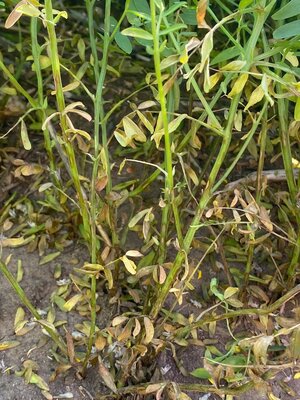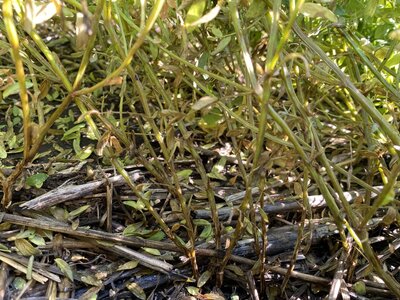Tips for managing anthracnose in lentils
January 18, 2024

Photo above shows Anthracnose lentil damage; leaflet and stem lesions under the crop canopy.
Photo taken at Marquis, SK, July 2020.
Monitoring pest populations in pulse crops is crucial for detecting emerging diseases and insects that can threaten your crop quality and yield.
In the 2022 Saskatchewan Lentil Crops Survey, anthracnose was the highest prevalent foliar disease with 78% of surveyed fields showing symptoms and an overall average incidence of 26%. These results were taken in a very dry growing season in southwest Saskatchewan, demonstrating that the disease is present even in the absence of moist, humid weather.
In lentils, a strain of anthracnose with insensitivity to all types of Group 11 (QoI, strobilurin) fungicides was identified in Saskatchewan in 2019. This discovery led to an Anthracnose Resistance Task Force being set up in 2020 to gain a better understanding of the extent and severity of Group 11 anthracnose insensitivity. The Task Force is co-led by Saskatchewan Pulse Growers, Ag Canada, along with industry partners and agronomists, including Syngenta Canada.
What is lentil anthracnose?
Anthracnose is a fungal disease in lentils caused by the pathogen Colletotrichum lentis, known to be present in lentil-growing regions of Western Canada. While the true damage to your lentil crop is not always visible from the side of the road, the impact on yield and quality is revealed when plants drop leaves or die prematurely.

Anthracnose lentil damage – leaf drop
Photo Taken at Assiniboia, SK July 2022.
Proper scouting: what to look for and what to do if you find it
Your best line of defense is to walk your field looking for
signs that anthracnose is threatening yield and quality in your lentils. This includes spots on leaflets and stems, stem lesions and stem girdling.
When disease has been found in past season and conditions for anthracnose are present, a fungicide should be applied proactively to prevent symptoms from developing. Once lesions are formed, a fungicide cannot repair cellular damage caused by the pathogen.

Anthracnose lentil damage – severe pressure devastating crop
Photo Taken at Earl Grey, SK July 2022.
Managing fungicide insensitivity in lentils
Saskatchewan growers are managing anthracnose with insensitivity to Group 11 fungicides in their lentil fields. The result is that growers can’t rely solely on a Group 11 active ingredient to provide effective disease control in these fields with high levels of insensitivity.
To manage insensitivity, growers should adopt an integrated approach that starts with crop rotation, residue management, and disease-free seed. Work with your agronomist to select a seed treatment, make informed in-season fungicide applications to minimize selection pressure, and reduce dependence on chemistries with a single mode of action.
Protect your lentils from anthracnose

You can protect the yield and quality in your lentils from Group 11 insensitive anthracnose with an early application of a preventative fungicide, such as Elatus® which has multiple modes of action.
Elatus brings together Solatenol®, an innovative Group 7 SDHI fungicide and azoxystrobin, for a second, proven mode of action. The Solatenol®component of Elatus® delivers highly effective protection against anthracnose and offers growers a built-in solution to help combat Group 11 insensitivity.
Anthracnose is no match for Elatus® fungicide when used alongside these application tips.
For more information on selecting the right fungicides for your lentil, reach out to your Syngenta rep or retail partner.
Always read and follow label directions. Elatus®, Solatenol® and the Syngenta logo are trademarks of a Syngenta Group Company.